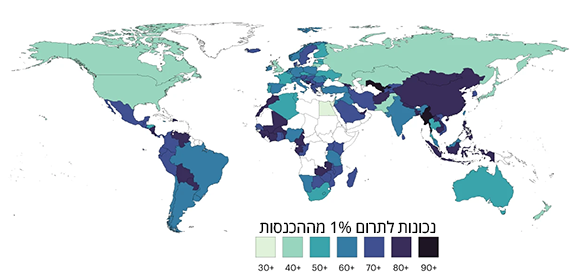Getting your Trinity Audio player ready...
Even in winter - breaking heat records has become the new normal around the world. This past February marked yet another milestone, being the warmest February ever recorded, as were January and December and every month since June 2023 - all were the warmest for their respective periods so far.
A detailed report by the World Meteorological Organization (WMO) showed that 2023 was the warmest year on record, by a significant margin, and found that the past nine years have consistently been the warmest years on record. The last decade was roughly 1.2 degrees Celsius warmer than the average for the years 1850-1900, and the past 12 months were about 1.56 degrees warmer compared to that same period.
This unprecedented rise in temperatures, starting in December, is largely attributed to increased concentrations of greenhouse gasses in the atmosphere. Sixty percent of the world's population, 4.8 billion people, experienced at least one day of extreme temperatures during this period - a phenomenon that would not have occurred without the impact of the carbon dioxide humanity has emitted into the atmosphere.
This exceptional heat has been linked to a series of extreme climate events globally. In South America, devastating wildfires consumed a million hectares of forests in Chile and Colombia, due to the heat, claiming the lives of 131 people. The severe heat also brought about severe droughts in the Amazon forests, taking a heavy ecological toll on the lakes in the area and the populations of species that depend on them, such as dolphins and fish.
Half of Mexico experienced drought conditions, with its capital grappling with an extreme water shortage. Across the Atlantic, Spain has been enduring a drought for already a thousand days in a row, with Barcelona facing a water emergency. Meanwhile, catastrophic floods have claimed over 350 lives in Congo and the Philippines.
3 View gallery


The exceptional heat is linked to a series of extreme climate events, among them fires in the area of Bogotá, the capital of Colombia, in January this year
(Photo: Shutterstock, Sebastian Delgado C)
Migratory peril
These days, millions of birds are passing over the Middle East as part of their spring migration. Cranes, storks, pelicans, and countless other species hurry to return from Africa to Europe, where they will enjoy an abundance of food and produce a new generation of birds.
Along the way, many of the birds will stop to rest and replenish their fat reserves in the Middle Eastern landscapes. The migration of birds and other animals is not only a fascinating spectacle, vital for the survival of the migrating species but also essential for the functioning of the ecological systems through which the animals pass.
The migration of fish, particularly salmon, to their natal lakes and streams, forms an important food source for grizzly bears and a host of other creatures. The African wildebeests moving in millions to new grazing lands fertilize these territories with their dung and are preyed upon in their masses, and migratory ducks spread seeds, mollusks, and other small animals across continents along their migratory route. Both large and small migrations connect ecosystems around the world.
However, since migratory animals move between different habitats, they are exposed to a wider range of threats, and their conservation is more complex. A stork migrating from Europe to Africa and back, for instance, needs suitable nature sites on both these continents and in the countries that lie on its migration path. Therefore, conserving migratory animals requires special effort and international cooperation.
The UN Convention on Migratory Species (CMS) works towards fostering the international cooperation necessary to protect migratory species that traverse national borders or face endangerment across much of their migratory paths.
In a recent landmark conference, a first-of-its-kind report analyzing the status of migratory animals globally was released. This extensive document delves into the conditions of approximately 1,200 migratory species under the convention’s protection—predominantly avian species—alongside an overview of around 3,000 additional migratory animal species. Following the report's publication, the 133 countries that signed the CMS treaty have adopted about a hundred new conservation measures, and a long-term, science-based strategic plan for the protection of 1,200 species. Among other achievements, a significant agreement was reached among 30 countries in Central Asia focusing on the conservation of migratory routes and breeding habitats for waterfowl, representing a breakthrough after two decades of fruitless discussions.
3 View gallery


Since migratory animals move between different habitats, they are exposed to a wider range of threats, and their conservation is more complex and challenging. Migrating pelicans at Hula Valley, Israel
(Photo: Shutterstock, Jeannette Katzir Photog)
According to the report, the two primary factors harming the populations of migratory species are overexploitation through fishing and hunting, and damage to their breeding grounds due to agriculture and infrastructure development. Each of these factors affects about seventy percent of the species under the convention’s protection. The majority of breeding grounds for migratory species are unprotected and at risk from human activity. The climate crisis, pollution, and invasive species were also identified as significant factors threatening the populations of migratory species.
Additionally, almost all fish species protected under the treaty are endangered, with their populations declining by an average of 90 percent since 1970. Many of these fish are sharks and other large fish species. The report also identified 400 migratory species at risk of extinction, not covered by the conference's mandate.
The report recommends a series of actions for the protection, rehabilitation, and connection of various breeding grounds, reduction of hunting and overfishing, the minimization of environmental pollution, the improvement of breeding grounds' resilience to climate change, as well as recommends efforts to be made for the advancement of science in this field.
According to Inger Andersen, Executive Director of the UN Environment Programme (UNEP), "[The current] report clearly shows us that unsustainable human activities are jeopardizing the future of migratory species – creatures who not only act as indicators of environmental change but play an integral role in maintaining the function and resilience of our planet’s complex ecosystems. The global community has an opportunity to translate this latest science of the pressures facing migratory species into concrete conservation action. Given the precarious situation of many of these animals, we cannot afford to delay, and must work together to make the recommendations a reality.”
3 View gallery


Willingness to Contribute to Climate Crisis Mitigation. The map illustrates the responses to the question “Would you be willing to pay one percent of your monthly income to reduce the climate crisis?” across various countries
(Photo: From the article, Andre et al., Nature Climate Change 2024)
Willingness to pay
Would you be willing to allocate one percent of your monthly income towards mitigating the climate crisis? Do you believe it's crucial that as a society, we try to reduce the climate crisis? Would you like to see your government intensify its efforts in this direction? A new survey study posed these questions to 130,000 individuals across 125 countries, which researchers claim faithfully represent the entire world population.
About 70 percent of the sample showed a willingness to pay one percent of their monthly income to mitigate the crisis, 86 percent agreed that we should act as a society to mitigate it, and almost 90 percent called for their governments to adopt more assertive measures.
According to the study, citizens of wealthier nations were less inclined to contribute financially to address the problem, despite their higher incomes and their countries' significant roles in contributing to the crisis. Additionally, the study found that the willingness to contribute financially to reducing the climate crisis tends to increase in countries experiencing higher temperatures and greater vulnerability to climate-related damages. The research also revealed a significant gap between our willingness to pay for climate crisis mitigation and our perception of our neighbors' willingness to pay. While about 70 percent of respondents were willing to pay one percent of their monthly income, only 43 percent believed their neighbors would be willing to do the same.
It is important to note that according to current estimates, the economic cost of climate damages is much higher than the cost of crisis mitigation according to the goals of the Paris Agreement - limiting global warming to one and a half degrees Celsius. Furthermore, a lack of climate action will lead to a doubling of the economic cost due to climate crisis damage by the end of the century. In other words, investment in reducing the climate crisis is also worthwhile in the long run from an economic standpoint.

